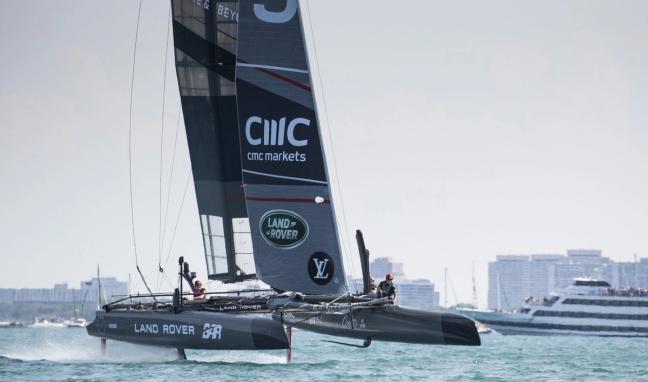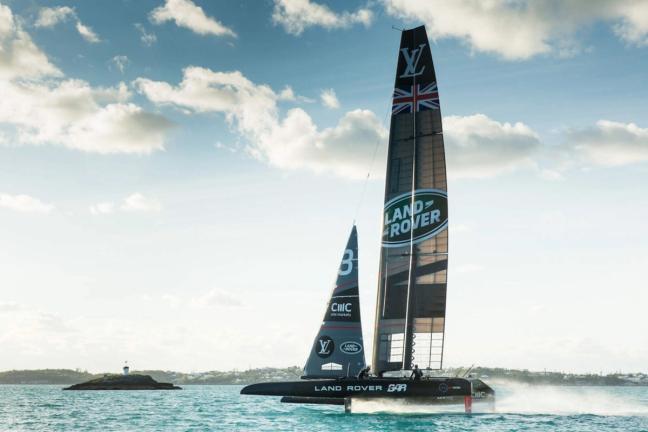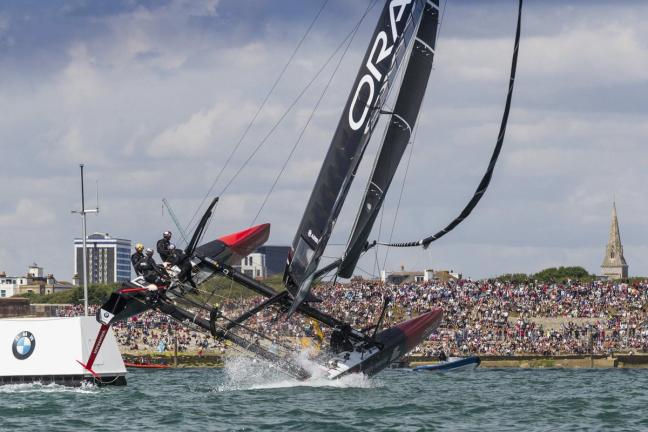No British team has ever won the America’s Cup. But 166 years of maritime hurt certainly aren’t for lack of trying. Britain’s representatives, Team BAR, have pushed engineering and their bodies to the limit in the pursuit of victory. Sam Rider travels to Bermuda for the team’s launch to experience the sheer power needed to win competitive sailing’s grandest prize
In the humid subtropical climate of Bermuda, the calm before the storm rarely lasts long. Last week, the peaceful turquoise waters of the Great Sound – the result of the island’s volatile volcanic past – were transformed into an amphitheatre of fullthrottle blood and thunder.
Six teams made up of thirty physically imposing men and six of the most advanced and high powered racing catamarans ever built battle for the 35th America’s Cup.
Six teams made up of thirty physically imposing men and six of the most advanced and high powered racing catamarans ever built battle for the 35th America’s Cup
Representing Great Britain is Land Rover BAR, the nation’s 21st entrant and first for 16 years. Team Ben Ainslie Racing is the brainchild of sailing royalty Sir Ben Ainslie, who we join at the team’s Bermuda base to witness the launch of the catamaran they hope will carry them to victory.
Since orchestrating one of the most astonishing sporting comebacks in history at the helm of Oracle Team USA at the 2013 America’s Cup, the four-time gold medal winner has devoted his life to assembling a British team capable of bringing the oldest trophy in international sport home – and become only the fifth nation to ever take the prize.
Think of the America’s Cup as Formula One on water
Think of the America’s Cup as Formula One on water. Yes it’s a boat race but the competition has changed beyond all recognition in its 166 year history as both a physical and design contest.
In the early years the beautiful J Class boats from the early 20th Century had heavy canvas sails that each weighed a tonne. The hulls were made out of timber, crews were 20-30 strong, they used nothing more technical than a compass and thousands of metres of rope and the maximum speeds were a mere eight knots.

Lloyd Images
In contrast, today’s America’s Cup machines wouldn’t look out of place in Bruce Wayne’s Batcave. The 2017 ACC boats boast the latest in aerodynamic technology. They’ve swapped one hull for two, canvas for carbon fibre and kevlar, and ropes have been replaced by 130m of hydraulic pipes and 1,200m of electronic cabling. At the same time, crews have been whittled down to six Olympic-grade athletes and the top speeds have jumped up to 50 knots plus.
But the greatest technological developments in recent years is how these boats are starting to fly – almost literally. They need to do this because water is really dense, up to 1,000 times more compact than air. The less the boat is in the water, the faster it can be.
That’s why the lightweight carbon fibre wing-sail on an America’s Cup yacht is bigger than the wing of a Boeing 737. It can provide enough energy to drive the boat forward and pick it up out of the water. The real kicker is a thing called a daggerboard, which was originally a stabilising device similar to a rudder.
In America’s Cup sailing, they made these deployable surfboard-sized daggerboards bend to create an underwater wing that will lift the boat’s hull entirely free of the water so it rides on four small hydrofoils. Since their introduction four years ago, race speeds have doubled.
The foils are lifting about 2.5 tonnes, or about the weight of a range rover, out of the water on a plank the size of a small kitchen table
“The foils are lifting about 2.5 tonnes, or about the weight of a range rover, out of the water on a plank the size of a small kitchen table,” explains BAR’s chief technical officer Andy Claughton. This reduces drag by north of 80% while wings on the rudders also help with the lifting, like the tail plane on an aircraft, so it can glide through the air at speeds reaching a breathtaking 60 miles per hour.
Team BAR’s boat, christened Rita by Ainslie’s wife, the former Sky Sports presenter Lady Georgie Ainslie, is the culmination of three years of work and 85,000 hours of painstaking design effort from their 120-strong Portsmouth-based outfit.
It has British red, white and blue coursing through its hydraulic veins, with Jaguar Land Rover, BAE Systems, BT, JCB and Renishaw integral to the team’s “best of British” strategy. Even the bottle of sparkling Nyetimber wine used for the naming ceremony is British.
The partnership with Land Rover is especially significant. The automotive giant’s engineering expertise in aerodynamic design, self-learning artificial intelligence and virtual-modelling technologies have all been plundered to help BAR’s boat go faster.

Land Rover BAR
Spearheading the department to maximise these marginal gains is Martin Whitmarsh, the former team principal at Formula One team McLaren, who Ainslie personally recruited as BAR’s CEO.
“In F1, generally the quickest car wins,” says Whitmarsh. “In America’s Cup, generally the quickest boat wins. That requires the latest and greatest engineering skill and insight to lead the race out of the water as much as on it.”
Speed is the priority – even on the outside
With these streamlined catamarans capable of achieving velocities almost three times faster than the wind, speed is the priority – even on the outside. Apart from the sponsor’s logo, Rita’s body is all gunmetal black and cadet grey, making her cut a brooding figure against the backdrop of an ominous cloudy sky. The reason for her muted tones? To win – at all costs.
Paint would have added extra kilograms they can’t afford to carry, a member of the design team reveals, which could make all the difference when hunting down that elusive prize this summer.
While technical design plays a prominent role, the physicality and mental fortitude of the six crew members on the boat is equally, if not more, pivotal.
“America’s Cup sailors have to develop nimble agility, precise coordination, unyielding strength and – for the four grinders on each team – phenomenal power endurance,” says the team’s strength and conditioning coach Alex Hopson.
Each of the six crew members, and the six back-ups, have an integral role to play. If skipper and tactician Ainslie is the brain and wing-trimmer Paul Campbell-James is the eyes, the four “grinders” on the team are the beating heart and tireless muscles that enable the boat to power through the water.
All the energy on the boat is generated by the grinders turning an arm-powered mechanism akin to a winch. This charges the boat’s hydraulic systems, enabling the wing trimmer to adjust the sail so the boat can turn – often at breakneck speed.
David “Freddie” Carr – who describes himself as a “big old diesel engine keeping everything ticking over” – is one of the team’s key grinders. He boils grinding down to being in the “pain cave” every race. “You’re north of 90% of max heart rate for about 25 constant minutes while also having to make split-second decisions on how to sail the boat,” he says.
“Ten years ago you’d stand up, grind like mad for six seconds, then sit down for two minutes. But now our hydraulic pumps on the boat need to be moved constantly. Our arms will be ticking over at 200-300 watts non-stop, then every 90sec we have to sprint up to 1,000 watts, leg it across the boat from one hull to the other and do it all again. It’s like doing an agility course when you’re exhausted on a moving trampoline doing 40 knots.”
To sustain these levels on the water, Hopson puts the crew through brutal training sessions in their bespoke Bermuda gym for 15 hours a week
To sustain these levels on the water, Hopson puts the crew through brutal training sessions in their bespoke Bermuda gym for 15 hours a week, sometimes running double daily sessions on top of hours on the water repeating physically and mentally draining manoeuvres.
“In recent years there’s been a step up in the physical requirements needed to sail these boats,” says Hopson. “The fitter and stronger the sailors, the more performance they can extract from the boat.”
It means the modern sailor has swapped tankards of beer in the clubhouse for shakers of protein in the gym and the herculean strength developed from winching ropes on the boat is now built with barbells.
Just as the boats have become streamlined yet more powerful, so have the sailors. On average the crew are 1.82m tall and 87.5kg heavy – equivalent to a lightweight fly half in rugby union. Yet while they need to keep their weight down, they can’t afford to sacrifice a single nanowatt of power.
“Our sailors need an engine comparable to that of a flat-out 20-minute time trialist in cycling coupled with the ability to turn on bouts of monstrous upper body strength and power like a rugby player or kayaker,” says Hopson.
To put that in context, you only need to look at their performances at last year’s British indoor rowing championships that the team entered to “give them a break from grinding”.
The challenge: rip through 2km on an ergo as fast as possible. The gold standard for most mortals is seven minutes. Carr and Bleddyn Mon tore through it in 6.11 and 6.16 minutes to finish 9th and 16th respectively. “Those who finished one to eight were rowers sent to the Rio Olympics,” says Hopson. At least if things don’t go to plan in sailing, the coxless pairs at Tokyo 2020 beckons.
Of course, pushing their bodies and the boat’s machinery to the limits on the water is not without risks. The crews must constantly fight to keep the catamarans from pitching forward, causing the bow of the hulls to hit the water and the vessel to somersault, known as a pitchpole.
Tragedy is fresh in the minds for all involved in the America’s Cup. In May 2013 British Olympic medallist Andrew Simpson was killed while training for the event when the Swedish Artemis yacht he was aboard flipped and broke into pieces. Simpson was trapped under the hull and couldn’t be revived.
Crews were wearing protective armour and helmets, but since Simpson’s death they are also required to wear portable air canisters in case they are trapped under water during a capsize.
“Safety is a big concern,” says Carr. “If you’re on a lead boat and you fall over the side the next thing that’s coming at you is the next boat’s daggerboard and a rudder like a knife edge.”
It takes a certain kind of character to excel in these conditions – and Team BAR are not short in that department. “Jono [Macbeth] is a big old grizzly bear looking man with a great big beard,” says Carr, describing the one Kiwi in the British ranks. “When we were sailing in Japan last year we got to meet and train with the nation’s sumo wrestlers, these mountains of muscle. Typically, Jono was the first one in the dohyō taking them on.

“We’ve also got Nick Hutton who’s grown up kite surfing, windsurfing, off-piste skiing, he loves cars, anything he can do to get his heart rate up. He’s a bit of a maverick and forever pushing boundaries. Then we’ve got Ben. On land he’s a true gent but put him behind a steering wheel, racing [rival skipper] Jimmy Spithill and you’ve never seen anything like it. He is absolutely ruthless on the water.”
To give us a flavour of what to expect when racing starts in May, we’re treated to a high-speed demonstration by Sweden’s Artemis Racing, watching aboard Team BAR’s RIB.
As the catamaran gathers momentum and the crew furiously work on the grinders, the boat gracefully rises like a plane taking off on the runway, floating over the surface until its hull is a full metre clear of the water.
As our three diesel engines roar to keep pace, the wind claws at any loose clothing and whistles past our ears at a deafening pitch. With every juddering slap of the boat on the flat Atlantic waters we’re violently jolted, straining our white knuckle grip on the handle bars. And we’re only going in a straight line.
Come race day, the America’s Cup crew will be battling the same distractions while executing high velocity tacks and jibes, averaging 23 knots around the course while the wind is trying to hurl them overboard. The team that wins will probably need to stay out of the water for the whole race, maintaining enough speed to virtually fly around the course riding on the foils.

That’s the challenge facing Team BAR: take flight and finally take the America’s Cup home. To do so will put an enormous strain on Rita, the crew and the technicians but that’s why the rewards involved are so great. “If there was ever a time to do it, this is it,” says Ainslie. “We’ve come a long way in a short time but ultimately our goal is to bring the cup home. We won’t stop until we get the job done.”
182cm average crew height
87.5kg average crew weight
24-40 squad age range
164bpm average heart race for a race
184bpm max heart rate recorded during a race
40 knots max speed of an AC45F catamaran
23 knots average speed of a race
12-15 hours per week of physical training
25,500kg average weight lifted by a sailor in a week
1.5% bodyweight: the target for key lifts of the bench press, bench pull and chin-up
1560 watts: max power recorded on arm grinder in training
35,000kcal consumed and expended per sailor each week
144 number of energy gels and bars consumed at an event by the team

Become a Gentleman’s Journal Member?
Like the Gentleman’s Journal? Why not join the Clubhouse, a special kind of private club where members receive offers and experiences from hand-picked, premium brands. You will also receive invites to exclusive events, the quarterly print magazine delivered directly to your door and your own membership card.


